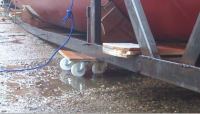It's finally arrived!
Categories
Tags
Recent articles
Ubuntu 16.10 LXC host on ZFS Root, with EFI and Time Machine
How to connect any serial device to the internet
It's here!
Finally after far too long waiting the boat turned up Easter Sunday. Typically the container unload seems to be done at a port or boat yard - certainly that's how the photos of the other F-33 unloadings I've seen did it. I decided not to do this, mainly because the option of unloading and winching the boat into the air by hand at my build site seemed a better option than unloading and assembling the boat and trailer, and driving both back through London.
So, to cut to the chase it all went fairly well. Here's a few notes which might help others taking this route.
The only thing I'd change would be to consult up the trailer plans before positioning all the bunks, and to put another dolly in the middle of the sled as by the time we'd extracted it from the container, the middle was sagging on the ground. It turns out 60x100x5mm steel box sections are actually quite bendy if you make them long enough. While I'm sure using a boatyard crane would have saved some nerves in the buildup, the alternative - having to assemble the trailer, load the boat, fit the floats (which, as it's a new model, I didn't have plans for) then drive from the coast to a major city on a bank holiday weekend - looks like a considerably worse option, even in hindsight.
Here's a video of the day, cobbled together from the few cameras we had that didn't fail just as we needed them.
PostScript
A few people have asked for details and costs for the import process. There's not a huge amount to tell as it was all handlded by the shipper (in my case, DB Schenker). Most of the paperwork for shipping was supplied by the builder - all I had to supply was the TARIC code which would determine the import duty into Europe - the closest match was 89039110, which from the Philippines meant no duty was payable. Other costs were shipping, freight handling charge, customs clearance charge and disbursement fees, which came to £4380 and was all paid to the shipping firm, VAT (also paid to the shipping firm, who managed the customs clearance), then the truck delivery fee - apparently £400 or so normally, much more if you do it on Easter Sunday. Those were my costs as of April 2014, I can't comment on whether they're typical.

 I built some dolly carts to wheel the sled into place. These looked quite pathetic
but
did the job - 2 x 2000x400x18mm sheets of ply with 3 x
I built some dolly carts to wheel the sled into place. These looked quite pathetic
but
did the job - 2 x 2000x400x18mm sheets of ply with 3 x  bowline. The load on all of these components was well within tolerance, a good thing
as we
found ourselves working under the boat while it was suspended.
bowline. The load on all of these components was well within tolerance, a good thing
as we
found ourselves working under the boat while it was suspended.